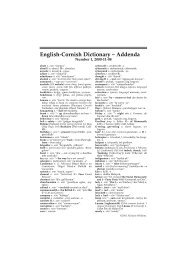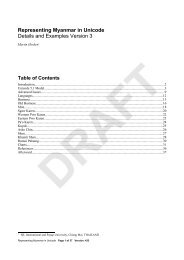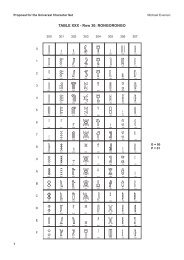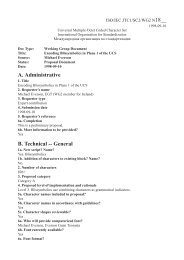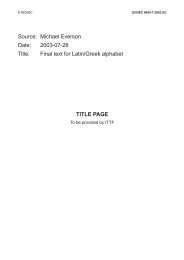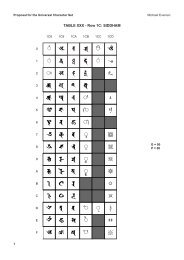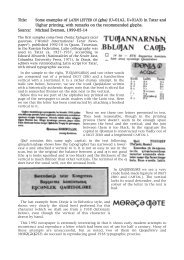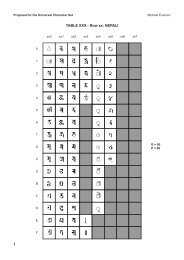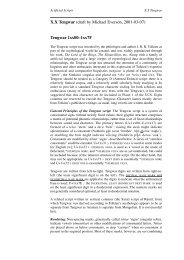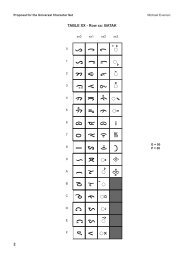Towards a Proposal to encode Egyptian Hieroglyphs in ... - Evertype
Towards a Proposal to encode Egyptian Hieroglyphs in ... - Evertype
Towards a Proposal to encode Egyptian Hieroglyphs in ... - Evertype
Create successful ePaper yourself
Turn your PDF publications into a flip-book with our unique Google optimized e-Paper software.
• by standardized sign number: √ C3, µ E34, ˚ G16, ¸ G17, É G24, ó G43<br />
• by conventional sound which works for only a m<strong>in</strong>ority of characters: µ wn, ¸ m, ó w<br />
The most convenient way of nam<strong>in</strong>g the characters is <strong>to</strong> identify them with their standard Egyp<strong>to</strong>logical<br />
catalogue numbers, s<strong>in</strong>ce otherwise the character names would be picturesque but rather long. The name<br />
EGYPTIAN HIEROGLYPH E034 refers uniquely and unambiguously <strong>to</strong> the DESERT HARE character used for the<br />
sound wn. Character names are padded with zeros here for two reasons. First, they will tend <strong>to</strong> sort<br />
correctly even when “smart” sort<strong>in</strong>g algorithms are not available. Second, the use of zeros offers a<br />
mechanism for dist<strong>in</strong>guish<strong>in</strong>g UCS character names from the many extant nam<strong>in</strong>g schemes for <strong>Egyptian</strong>,<br />
s<strong>in</strong>ce formally-standardized UCS characters will have a different status than font collections like<br />
Hieroglyphica (Grimal et al. 1993 and 2000) or other works. Gard<strong>in</strong>er uses A44 for › a k<strong>in</strong>g of Upper<br />
Egypt with flagellum; Collier and Manley use A44 for fi an arm hold<strong>in</strong>g the nh. bt-wand; Möller uses<br />
A44 for fl a soldier with bow and quiver. The UCS names A044, D045, and A012 uniquely identify the<br />
characters and also identifies the designation as a UCS name.<br />
As is traditional, <strong>Egyptian</strong> <strong>Hieroglyphs</strong> are classified accord<strong>in</strong>g <strong>to</strong> letters of the alphabet, so A000 is<br />
“Man and his occupations”, B000 is “Woman and her occupations”, C000 is “Anthropomorphic deities”,<br />
D000 is “Parts of the human body”, E000 is “Mammals”, F000 is “Parts of mammals”, G000 is “Birds”,<br />
H000 is “Parts of birds”, I000 is “Amphibious animals, reptiles, etc.”, K000 is “Fishes and parts of<br />
fishes”, L000 is Invertebrata and lesser animals”, M000 is “Trees and plants”, N000 is “Sky, earth,<br />
water”, O000 is “Build<strong>in</strong>gs, parts of build<strong>in</strong>gs, etc.”, P000 is “Ships and parts of ships”, Q000 is<br />
“Domestic and funerary furniture”, R000 is “Temple furniture and sacred emblems”, S000 is “Crowns,<br />
dress, staves, etc.”, T000 is “Warfare, hunt<strong>in</strong>g, butchery”, U000 is “Agriculture, crafts, and professions”,<br />
V000 is “Rope, fibre, baskets, bags, etc.”, W000 is “Vessels of s<strong>to</strong>ne and earthenware”, X000 is “Loaves<br />
and cakes”, Y000 is “Writ<strong>in</strong>gs, games, music”, Z000 is “Strokes, signs derived from Hieratic,<br />
geometrical features”, and AA000 is used for “Unclassified” signs. (Note: some may have been classified<br />
s<strong>in</strong>ce the category was assigned but we have not re-assigned them.) In Gard<strong>in</strong>er 1929, 1931, and 1953 a<br />
section Ff “Signs for transcription from Hieratic” appears, but as these are identified as variants of other<br />
characters, they are named accord<strong>in</strong>gly here (so ÷ G1928:95:Ff2 is a “substitute for ◊ V7”, so it is<br />
<strong>encode</strong>d as V007-A). In Gard<strong>in</strong>er 1953, a section Nn is given <strong>to</strong> represent the nomes of Egypt, with L<br />
prefixed <strong>to</strong> the number for the nomes of Lower Egypt, and U for the nomes of Upper Egypt. All of those<br />
characters conta<strong>in</strong> ‚ N024, which <strong>in</strong>dicates land marked out with irrigation runnels, which is<br />
presumably why Gard<strong>in</strong>er used the notation “Nn” for the nomes. Gard<strong>in</strong>er gives NnL1 for „; the nam<strong>in</strong>g<br />
convention here calls it NL001 rather than NNL001. An aesthetic compla<strong>in</strong>t might be made about O000,<br />
but Gard<strong>in</strong>er used the letter O <strong>in</strong> his classification and we ma<strong>in</strong>ta<strong>in</strong> that the lead<strong>in</strong>g zero is a useful<br />
convention for the reasons given above.<br />
Gard<strong>in</strong>er identified some variants of characters by unique catalogue numbers, and others by extend<strong>in</strong>g<br />
add<strong>in</strong>g one or two asterisks (and <strong>in</strong> one <strong>in</strong>stance a and a'). UCS nam<strong>in</strong>g convention does not allow the<br />
use of asterisks, but it is traditional <strong>to</strong> add letters of the alphabet. In the convention we employ, these<br />
letters are added <strong>to</strong> the base name follow<strong>in</strong>g a hyphen. Thus Gard<strong>in</strong>er’s ‡ G7, · G7*, and ‚ G7** are<br />
G007, G007-A, and G007-B here respectively. We have found that the use of the hyphen facilitates<br />
read<strong>in</strong>g the names list, and like the lead<strong>in</strong>g zeros, helps <strong>to</strong> dist<strong>in</strong>guish the UCS character names from<br />
other conventions. Letters for variants are <strong>to</strong> be added serially as the <strong>Egyptian</strong> reper<strong>to</strong>ire is expanded.<br />
8. Numbers. Gard<strong>in</strong>er lists only 1, 2, and 3 with catalogue numbers <strong>in</strong> his <strong>Egyptian</strong> Grammar; these<br />
signs fulfill other functions apart from that of numeral. He describes numbers <strong>in</strong> detail <strong>in</strong> §§259–266.<br />
Möller’s three volumes on Hieratic palaeography (1909, 1927, 1936) do give catalogue numbers (based<br />
on typographer Ferd<strong>in</strong>and The<strong>in</strong>hardt’s system) and those references have been added <strong>to</strong> the database <strong>to</strong><br />
3





